Athena
 From Nwe
From Nwe In Greek mythology, Athena (Greek: Άθηνά, Athēnâ, or Ἀθήνη, Athénē; Latin: Minerva) was a multifaceted Greek goddess whose spheres of influence centered around wisdom and strategy.[1] She was known as the companion of heroes, protector of cities, and general patron of civilized, urban life. Most importantly, the goddess had a strong ethical component, as she was nearly unique among the Olympians for the fact that virtually no Greek mythic tales depicted her in an amoral or immoral light.[2]
Athena was renowned for her role as a protector of cities and thus was worshiped in Hellenistic culture as Athena Polias ("Athena of the city"). In particular, she had a special relationship with the city of Athens, as can be shown by the etymological connection of the city with her name.[3][4] In classical myth, she never had a consort or lover, and thus was additionally known as Athena Parthenos ("Athena the virgin"), a name that was enshrined in stone as the Parthenon, on the Acropolis in Athens.
In sculpture, Athena often wore a breastplate (called the Aegis given to her by her father, Zeus),[5] a helmet and a shield bearing the Gorgon Medusa's head, a votive gift from Perseus. She was associated with battlefield strategy in contrast to the god Ares, who was associated with madness, violence and bloodlust.
Name, etymology and origin
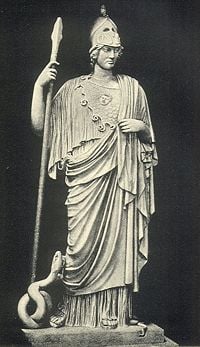
In the pre-Hellenic world, it seems likely that Athena was a Minoan (or other non-Mycenaean) deity who achieved early prominence and was exported around the early Hellenic world for her role in defending the polis from hostilities. Numerous hypotheses have been put forward concerning the initial origin of her name, with some possibilities including a Lydian provenance,[6] Crete,[7] or a pre-Mycenaean syncretism between the Tyrrhenian "ati," meaning "mother" and the Hurrian Goddess "Hannahannah," which was shortened in various places to "Ana." In Mycenaean Greek, she is possibly referenced in a single inscription in the Linear B tablets, where A-ta-na-po-ti-ni-ja (Athana potniya) appears on a text from the Late Minoan II-era "Room of the Chariot Tablets" in Knossos, the earliest Linear B archive anywhere.[8] Though this phrase is often translated as "Mistress Athena," it literally means "the potnia of At(h)ana," which could simply mean "the Lady of Athens."[9] The ambiguity of this relationship is also attested to by Burkert (1985), who notes that "whether the goddess was named after the city or the city after the goddess is an ancient dispute."[10]
In his dialogue Cratylus, Plato gives an etymology of Athena's name based on the view of the ancient Athenians:
That is a graver matter, and there, my friend, the modern interpreters of Homer may, I think, assist in explaining the view of the ancients. For most of these in their explanations of the poet, assert that he meant by Athene "mind" (nous) and "intelligence" (dianoia), and the maker of names appears to have had a singular notion about her; and indeed calls her by a still higher title, "divine intelligence" (Thou noesis), as though he would say: This is she who has the mind better than others. Nor shall we be far wrong in supposing that the author of it wished to identify this Goddess with moral intelligence (en ethei noesin), and therefore gave her the name ethonoe; which, however, either he or his successors have altered into what they thought a nicer form, and called her Athene." (Cratylus 407b).</ref> where he derives her name from A-theo-noa (A-θεο-νόα) or E-theo-noa (H-θεο-νόα) meaning "the mind of God."[11]
Some authors believe that in early times, Athena was an owl herself, or a bird goddess in general.[12] In the development of her iconography, starting from archaic vase-paintings, she dropped her prophylactic owl-mask before she lost her wings. On this topic, Jane Ellen Harrison remarked that "Athene, by the time she appears in art has completely shed her animal form, has reduced the shapes she once wore of snake and bird to attributes, but occasionally in black-figure vase-paintings she still appears with wings."[13]
Epithets
In poetry from Homer onward, Athena's most common epithet is glaukopis (γλαυκώπις), which is usually translated "bright-eyed" or "with gleaming eyes."[14] It is a combination of glaukos (γλαύκος, meaning "gleaming," "silvery," and later, "bluish-green" or "gray") and ops (ώψ, "eye," or sometimes, "face"). It is interesting to note that glaux (γλαύξ, "owl") is from the same root, presumably because of its own distinctive eyes. The bird that sees in the night is closely associated with the goddess of wisdom: in archaic images, she is frequently depicted with an owl perched on her head. In earlier times, Athena may well have been a bird goddess, similar to the unknown goddess depicted with owls, wings and bird talons on the Burney relief, a Mesopotamian terracotta relief of the early second millennium B.C.E.
Other epithets include:
- Atrytone (Άτρυτώνη), the unwearying
- Athena Ergane (Παρθένος), the patron of craftsmen and artisans
- Athena Hippeia or Athena Hippia, the inventor of the chariot
- Parthénos (= virgin), the aspect of her character that was memorialized in the Parthenon
- Athena Polias ("of the city"), the protectress of the city (polis) - a name used in conjunction with Athens, Argos, Sparta, Gortyn, Lindos, and Larisa
- Promachos (Ή Πρόμαχος), the "pre-fighter," (i.e. the one who leads into battle).[15]
Mythology
Birth of Athena, daughter of Zeus
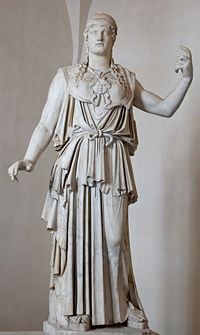
In the Olympian pantheon, Athena was represented as the favorite daughter of Zeus, carried and birthed by her divine father without the necessity of any female intervention.[16] The story of her miraculous birth comes in several versions. In the one most commonly cited, Zeus lay with Metis, the goddess of crafty thought and wisdom, but immediately feared the consequences. It had been prophesied that Metis would bear children more powerful than the sire, even if the father was Zeus himself.[17] In order to forestall these dire consequences, Zeus "put her away inside his own belly" and "swallowed her down all of a sudden."[18] Unfortunately, he was too late: Metis had already conceived a child. The Sky God, blind to the state of his now-consumed consort, resumed his life as usual. However, the ensuing period of normalcy came to an abrupt halt nine months later, when Zeus began to suffer cripplingly painful headaches. Trying to relieve the pressure in their ruler's cranium, one of the lesser gods (often Prometheus, Hephaestus, or Hermes) proceeded to cleaved Zeus's head with the double-headed Minoan axe. At this point, Athena leaped from his newly-opened skull, fully grown and armed, and "cried aloud with a mighty shout. The Sky [Ouranos] and mother Earth [Gaia] shuddered before her."[19]
Athena's origins cemented the connection between herself and her father, to the extent that many of her epithets (including Agoraia ("protector of the agora"), Polias ("guardian of the city"), Xenia ("maintainer of hospitality and guardian of strangers") were shared with her divine pater. The strength of this connection is further evidenced by Zeus' tendency to dote upon his special daughter, a phenomenon that receives some attention in both the Odyssey and the Iliad.[20]
It should be noted that this entire episode can be seen to rest upon the patriarchal thesis that Athena's femininity had to somehow be explained away (given her stereotypically masculine areas of influence). This bias is additionally demonstrated by in Hesiod's codicil to this tale, where Hera, irritated by her husband's seemingly asexual reproduction, decided to make herself pregnant. Eventually, she succeeded in giving birth to the lumpen blacksmith god, Hephaestus. Describing this discrepancy, Hurwit notes that "the fact that Zeus gave birth to a perfect daughter, while Hera, by herself, could only engender the crippled Hephaestus, again argues for the superior role of the male."[21]
Other hypothetical origins
While the above tale is the only extant account of Athena's birth, some modern scholars (led by etymological concerns) have suggested that the goddess may have been a pre-Olympian deity whose place in the pantheon was achieved at a later date (using the syncretic tale described above). The goddess' most puzzling epithet, at least in this context, is Tritogeneia (also Trito, Tritonis, Tritoneia, Tritogenes). While this name could imply a paternal connection between the goddess and Triton (or even Poseidon),[22] the evidence for such an interpretation is both confusing and partial.[23] Intriguingly, this epithet caused the Greeks themselves some consternation, as they attempted to explain it away using faulty etymologies to represent it as "born from the head" (a linguistically dubious assertion).[24] As summarized by Rose:
An ancient title of the goddess is Tritogeneia; whatever that may mean—and Homer seems already to have forgotten—it certainly does not mean 'daughter of Zeus.' The syllable gen, if it is Greek, would most naturally mean "born," and trito- suggests the sea-gods Amphitrite and Triton.... If we knew what language the names of Triton and his etymological kin belonged, and what they originally meant, it would doubtless throw some light on the origin of Athen and her mythology in prehellenic times; but unfortunately, we do not.[25]
Athena Parthenos: Virgin Athena
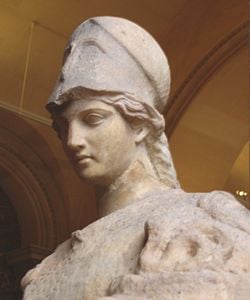
Unlike the majority of Olympian gods, Athena never had a consort or lover, and thus was also known as Athena Parthenos ("Virgin Athena"). Her most famous temple, the Parthenon, on the Acropolis in Athens takes its name from this title. This moniker was not merely an observation of her virginity, but recognition of her role as enforcer of rules of sexual modesty and ritual mystery. This role is expressed in a number of stories about Athena.
Erichthonius
The tale of the birth of Erichthonius is the most famous (and most sexually-charged) tale surrounding the virginal Athena. In it, the goddess is innocently traversing the site of the Athenian Acropolis when she is spotted by the misshapen (and sexually-repressed) Hephaestus. The smith-god, whose lust became instantly inflamed at the sight of the beautiful goddess, rushed to her side and attempted to rape her. Though she successfully repelled him, Athena was still struck in the leg by some of his seed. Repulsed, she wiped it off with a cloth and threw it to the ground. From there, it fertilized the earth and Erichthonius was born. Despite the child's illicit origins, Athena generously chose to raise it as a foster mother.[26]
Erichthonius later became king of Athens and implemented many beneficial changes to Athenian culture. During this time, Athena frequently aided and protected him.
Medusa and Tiresias
Two other major episodes concern Athena and sexuality: one concerning the Gorgon, Medusa; the other, the blind seer, Tiresias.
The first tale, which has an etiological component, sets the stage by describing Medusa, stating that, unlike her two sister Gorgons, she was mortal and extremely beautiful. Unfortunately, she happened to have sex with—or be raped by—Poseidon in a temple of Athena. Upon discovering the desecration of her temple, Athena changed Medusa's form to match that of her sister Gorgons as punishment. Medusa's hair turned into snakes, her lower body was transformed, and her gaze became capable of literally petrifying any living creature that it rested upon.
In one version of the Tiresias myth, Tiresias stumbled upon Athena bathing, and was blinded by her nakedness.[27] To compensate him for his loss, she sent serpents to lick his ears, which gave him the gift of prophecy.
Lady of Athens
Athena's connection with the city of Athens (described above) was descriptively addressed in a classical account of a contest between Athena and Poseidon, where each sought to be the patron deity of the fledgling community.[28] They agreed that each would give the Athenians one gift and that patron would be selected based on whichever gift the mortals preferred. Poseidon struck the ground with his trident and a spring sprang up; this gave them a means of trade and water, but it was salty and not very good for drinking. Athena, however, offered them the first domesticated olive tree. The Athenians (or their king, Cecrops) accepted the olive tree and along with it Athena as their patron, for the olive tree brought wood, oil and food. This is thought to commemorate a clash between the inhabitants during Mycenaean times and newer immigrants.[29] Despite this strong affiliation, Athena was also the patron goddess of several other cities, notably Sparta.
Counselor
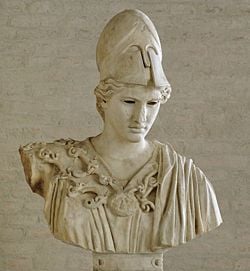
Given her association with wit and cleverness, it is not surprising that many heroes turned to Athena for guidance when confounded by a particularly daunting obstacle. For some examples, note that Athena guided Perseus in his quest to behead Medusa; she taught Jason the necessary skills to construct the Argo; she instructed Heracles in the correct manner of skinning the Nemean Lion (by using its own claws to cut through its seemingly impenetrable hide); she also helped Heracles to defeat the Stymphalian Birds, and to navigate the underworld so as to capture Cerberos.
Odysseus' cunning and shrewd nature quickly won Athena's favor, though she was largely restricted to aiding him from afar during his journey home from Troy, given that she could not directly contradict the edicts of the wrathful Poseidon. It is not until he washes up on the shore of an unknown island that Athena begins to intervene directly. She appears in the dreams of a local princess (Nausicaa) to ensure that the young woman would rescue Odysseus, which eventually allows the hero access to a ship and passage back to Ithaca. Once he arrives, Athena herself appears to the crafty hero in disguise, which inspires him to use the garments of an old beggar to penetrate his former castle. Further, the goddess also helps reunite Odysseus with his long-lost son (Telemachus) and provides tactical advice to both during their final dramatic confrontation with the amassed suitors of Penelope (Odysseus' grieving wife).
Arachne
The fable of Arachne is a late addition to Greek mythology[30] that does not appear in the mythic repertory drawn upon by the Attic vase-painters. Arachne, whose name simply means "spider" (αράχνη), was the daughter of a famous dyer in Hypaipa of Lydia. She became so convinced of her skill as a weaver that she began to claiming that her abilities were greater than those of Athena herself. In her typically ethical style, Athena gave Arachne a chance to redeem herself by assuming the form of an old woman and warning the young woman not to offend the gods. Unsurprisingly, Arachne scoffed and wished for a weaving contest, so she could prove her skill. Unable to stomach the woman's hubris, Athena revealed herself and accepted her challenge.
To begin, Athena wove the scene of her victory over Poseidon in determining the patronage of Athens. In retaliation, Arachne created a enormous and detailed tapestry featuring 21 episodes of the infidelity of the gods, including Zeus being unfaithful with Leda, Europa, and Danae.
Even Athena admitted that Arachne's work was flawless, but was outraged at Arachne's disrespectful choice of subject matter, in that her work highlighted the failings and transgressions of the gods.[31] Finally losing her temper, Athena destroyed Arachne's tapestry and loom, striking it with her shuttle. Realizing the depth of her folly, Arachne hanged herself.
In Ovid's telling, Athena then took pity on Arachne and transformed her into a spider.
Cult
In many ways, the cult of Athena was second only to the cult of Zeus in its prominence and influence. In each of her various guises (discussed above), she was the recipient of religious observance at temples across the ancient Hellenic state, from Athens and Sparta, to Thebes and Ithaca: "As illustrations of the universality of her cult we have the testimony of Homer and many of the heroic legends, and the records of local cults afford ample proof."[32] In all of these contexts, she was a frequent recipient of sacrifice (most typically cows, sheep and goats). She was also honored by a yearly festival called the Panathenaia, which featured a re-dedication of the city through a perambulatory procession, athletic and artistic competitions, and animal sacrifice (whose victims were then redistributed to the public).[33]
With the epithet Athena Polias ("of the city"), Athena was the protectress of Athens and its Acropolis, but also of many other cities, including Argos, Sparta, Gortyn, Lindos, and Larisa. In each of these cities her temple was frequently the major temple on the acropolis.[34] This connection between religious observance and civic unity prompted Farnell to conclude:
...her religion is eminently political, growing and waning with the Greek polis: her πρόνοια [provision] was the 'providence' of the city-community in war and peace. The poets sometimes placed her, indeed, by the side of Zeus as his peer in power and works, and she borrowed many titles of his; but her public worship and the religious utterances of the poets concerning her are less rich in spiritual content, less satisfying to the private conscience or to individual morality. The virtues she inspires and approves are, according to the panegyric of Aristides, the public virtues of political wisdom, courage, concord, discipline, and self-restraint.... Her worship, then, had elements of nobility as the incarnation of public law and of the virtues on which that rests.[35]
In classical art
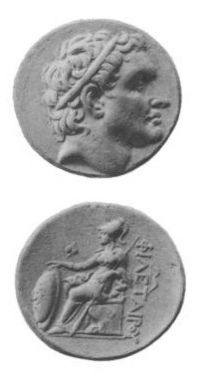
Athena is classically portrayed wearing full armor, with the helmet raised high on the forehead (which reveals her aristocratic yet feminine visage); she carries a spear and a shield with the head of the gorgon Medusa mounted upon it. It is in this standing posture that she was depicted in Phidias's lost gold and ivory statue of her, a towering (12-meter) version of Athena Parthenos that used to adorn Parthenon. Athena is also often depicted with an owl (a symbol of wisdom) sitting on one of her shoulders. In earlier, archaic portraits of Athena in black-figure pottery, the goddess retains some of her pre-Hellenic (possibly Minoan) characteristics, such as enormous bird wings.
Apart from her attributes, there seems to be a relative consensus in sculpture from the fifth century onward as to what Athena looked like. Most noticeable in the face is a high nose with a relatively high bridge that emerges naturally from the forehead. The eyes are typically somewhat deeply set. The lips are usually full but the mouth is fairly narrow, usually just slightly wider than the nose. The neck is slender, graceful and somewhat long. The net result is a serene, somewhat aloof beauty.
Notes
- ↑ Athena's focus on wisdom became especially predominant with the rapprochement of Greek philosophy and religion in the later fifth century B.C.E. Chap. 7 ("Philosophical Religion") in Walter Burkert's magisterial Greek Religion (Oxford: Blackwell, 1985, ISBN 0631112413) treats these transformations in some detail.
- ↑ H. J. Rose, A Handbook of Greek Mythology (New York: E. P. Dutton & Co., 1959, ISBN 0525470417), 108.
- ↑ Burkert, 139: "Whether the goddess was named after the city or the city after the goddess is an ancient dispute."
- ↑ This ancient relationship is further attested to by an archaic myth where she was described as the mother of Erichthonius (one of the founders of Athens) following a failed rape attempt. Pseudo-Apollodorus, Bibliotheke 3.14.6.
- ↑ The Sky God's association with this artifact is attested to by the fact that he is also, on occasion, described as "Aegis-bearing Zeus." Theoi.com has a list of the various mythic texts that use this moniker to describe Zeus. Retrieved September 6, 2007.
- ↑ G. Neumann, "Der lydische Name der Athena. Neulesung der lydischen Inschrift Nr. 40" (“The Lydian name of Athena. New reading of the Lydian inscription No. 40”). Kadmos 6 (1967): 80-87.
- ↑ See, for example, Martin P. Nilsson, The Minoan-Mycenaean Religion and its Survival in Greek Religion (Lund: C. W. K. Gleerup, 1950); Virginia Hicks, "The Language of the Minoans," Anistoriton: Viewpoints 9 (September 2005). Retrieved September 6, 2007.
- ↑ Text 208 in Michael Ventris and John Chadwick, Documents in Mycenaean Greek, 2nd ed. (Cambridge: Cambridge University Press, 1973, ISBN 0521085586).
- ↑ Thomas Palaima, "Appendix One: Linear B Sources" in Anthology of Classical Myth: Primary Sources in Translation, ed. Stephen Trzaskoma, et al. (Indianapolis, IN: Hackett, 2004, ISBN 0872207218), 444.
- ↑ Burkert, 139. Also, Carl Ruck and Danny Staples, in The World of Classical Myth: Gods and Goddesses, Heroines and Heroes (Durham, NC: Carolina Academic Press, 1994, ISBN 0890895759), offer a compelling argument that the goddess' name was associated with the plural name her sisterhood, the Athenai, from the earliest times: "[Mycenae] was the city where the Goddess was called Mykene, and Mycenae is named in the plural for the sisterhood of females who tended her there. At Thebes she was called Thebe, and the city again a plural, Thebae (or Thebes, where the 's' is the plural formation). Similarly, at Athens she was called Athena, and the city Athenae (or Athens, again a plural) (24).
- ↑ Plato, Cratylus, 407b. Available online from Perseus Digital Library, Tufts University. Retrieved September 6, 2007.
- ↑ For a good introduction to this theory, as supported by archaeological evidence, see E. M. Douglas, "The Owl of Athena," The Journal of Hellenic Studies 32 (1912): 174-178.
- ↑ Harrison 1922, 306: Fig. 84: Detail of a cup in the Faina collection. Retrieved September 6, 2007.
- ↑ Henry George Liddell and Robert Scott, An Intermediate Greek-English Lexicon (1940). Available online from the Perseus Digital Library, Tufts University. Retrieved September 6, 2007.
- ↑ See Theoi.com: “Titles of Athena” for a complete listing of these epithets with references to the various passages in classical texts where they are used. Retrieved September 6, 2007.
- ↑ Harrison's famous characterization of this myth-element as "a desperate theological expedient to rid an earth-born Kore of her matriarchal conditions" has never been refuted (Harrison 1922, 302). This explicitly patriarchal depiction could be seen as a way that the male-dominated Hellenic society could accept the centrality of a female deity in many masculine pursuits (carpentry, law, warfare), a point that is cogently argued in Jeffrey M. Hurwit's "Beautiful Evil: Pandora and the Athena Parthenos," American Journal of Archaeology 99(2) (April 1995): 171-186, 178-180. See also Powell, 95; Farnell (vol. 1), 284-285.
- ↑ Compare this prophecy concerning Thetis, which had initially motivated Cronus to begin consuming his own children (one of which was Zeus).
- ↑ Hesiod, [Theogony, 890 and 924. Available online from the Perseus Digital Library, Tufts University. Retrieved September 6, 2007.
- ↑ Pindar, Olympian Odes 7:36-38. Available online from the Perseus Digital Library, Tufts University. Retrieved September 6, 2007.
- ↑ Timothy Gantz, Early Greek Myth: A Guide to Literary and Artistic Sources (Baltimore, MD: Johns Hopkins University Press, 1993, ISBN 080184410X), 84.
- ↑ Hurwit, 180; paraphrasing Hesiod's Theogony 927-929.
- ↑ Karl Kerenyi, in The Gods of the Greeks (London & New York: Thames and Hudson, 1951, ISBN 0500270481), suggests that "Tritogeneia did not mean that she came into the world on any particular river or lake, but that she was born of the water itself; for the name Triton seems to be associated with water generally" (128).
- ↑ Farnell (1907) explores this enigma in some detail (vol. 1, 265-270).
- ↑ Farnell (vol. 1), 265-266.
- ↑ Rose, 108-109.
- ↑ Pseudo-Apollodorus, Bibliotheke 3.14.6. See also Powell, 192.
- ↑ Robert Graves, "The Nature and Deeds of Athena" in The Greek Myths I (London: Penguin Books, 1993, ISBN 0140171991), 25.
- ↑ The Library of Apollodorus 3.14.1; Ovid, Metamorphoses 6.70; Theoi.com: “Myths of Athena” for a comprehensive list of sources. Retrieved September 6, 2007.
- ↑ Further evidence of this hypothesis can be found in Thalia Phillies Howe's "Zeus Herkeios: Thematic Unity in the Hekatompedon Sculptures," American Journal of Archaeology 59(4) (Oct. 1955): 287-301, which considers various artistic works from an intermediary period when the conflict between older, Poseidon-centered beliefs and newer, Athena-centered beliefs was still being played out.
- ↑ The tale is recorded in Ovid's Metamorphoses (5-54 and 129-145) and mentioned in Virgil's Georgics (iv, 246).
- ↑ This takes for granted a late, moralizing view of Greek myth.
- ↑ Farnell (vol. 1), 258, 259-260.
- ↑ Matthew Dillon, Pilgrims and Pilgrimage in Ancient Greece (London and New York: Routledge, 1997, ISBN 0415127750), 141-143.
- ↑ Burkert, 140.
- ↑ Farnell (vol. 1), 319.
Bibliography
- Burkert, Walter. Greek Religion: Archaic and Classical. Translated by John Raffan. Oxford: Blackwell, 1985. ISBN 0631112413
- Dillon, Matthew. Pilgrims and Pilgrimage in Ancient Greece. London; New York: Routledge, 1997. ISBN 0415127750
- Douglas, E. M. "The Owl of Athena." The Journal of Hellenic Studies 32 (1912): 174-178.
- Farnell, Lewis Richard. The Cults of the Greek States (5 vols.). Oxford: Clarendon Press, 1907.
- Gantz, Timothy. Early Greek Myth: A Guide to Literary and Artistic Sources. Baltimore, MD: Johns Hopkins University Press, 1993. ISBN 080184410X
- Graves, Robert. The Greek Myths (Complete Edition). London: Penguin Books, 1993. ISBN 0140171991
- Harrison, Jane Ellen. Prolegomena to the Study of Greek Religion. Cambridge: Cambridge University Press, 1908.
- Hurwit, Jeffrey M. "Beautiful Evil: Pandora and the Athena Parthenos." American Journal of Archaeology 99(2) (April 1995): 171-186.
- Kerenyi, Karl. The Gods of the Greeks. London & New York: Thames and Hudson, 1951. ISBN 0500270481
- Mikalson, Jon D. Ancient Greek Religion. Malden, MA: Blackwell, 2005. ISBN 0631232222
- Palaima, Thomas. "Appendix One: Linear B Sources." Anthology of Classical Myth: Primary Sources in Translation. Edited by Stephen Trzaskoma, et al. Indianapolis, IN: Hackett, 2004. ISBN 0872207218
- Parke, H. W. Festivals of the Athenians. Ithaca, NY: Cornell University Press, 1977. ISBN 0801410541
- Powell, Barry B. Classical Myth, 2nd ed. Upper Saddle River, NJ: Prentice Hall, 1998. ISBN 0137167148
- Rose, H. J. A Handbook of Greek Mythology. New York: E. P. Dutton & Co., 1959. ISBN 0525470417
- Ruck, Carl A. P. and Danny Staples. The World of Classical Myth: Gods and Goddesses, Heroines and Heroes. Durham, NC: Carolina Academic Press, 1994. ISBN 0890895759
- Telenius, Seppo Sakari. Athena-Artemis. Helsinki: Kirja Kerrallaan, 2005. ISBN 9529205600
- Ventris, Michael and John Chadwick, Documents in Mycenaean Greek, 2nd ed. Cambridge: Cambridge University Press, 1973. ISBN 0521085586
External links
All links retrieved November 9, 2021
- The Sculptures of the Goddess Athena – The Museum of the Goddess Athena by Roy George
- Theoi.com: Cult of Athena
Credits
New World Encyclopedia writers and editors rewrote and completed the Wikipedia article in accordance with New World Encyclopedia standards. This article abides by terms of the Creative Commons CC-by-sa 3.0 License (CC-by-sa), which may be used and disseminated with proper attribution. Credit is due under the terms of this license that can reference both the New World Encyclopedia contributors and the selfless volunteer contributors of the Wikimedia Foundation. To cite this article click here for a list of acceptable citing formats.The history of earlier contributions by wikipedians is accessible to researchers here:
The history of this article since it was imported to New World Encyclopedia:
Note: Some restrictions may apply to use of individual images which are separately licensed.
↧ Download as ZWI file | Last modified: 02/03/2023 22:35:47 | 11 views
☰ Source: https://www.newworldencyclopedia.org/entry/Athena | License: CC BY-SA 3.0
 ZWI signed:
ZWI signed: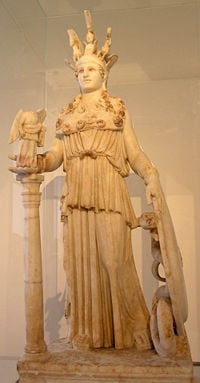

 KSF
KSF